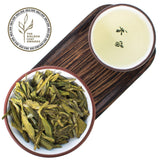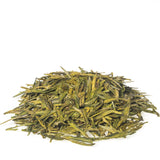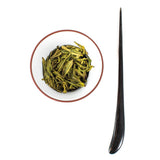As the morning mist clung to Shi Feng's peaks, young Shao asked his mentor, while sipping a vibrant brew: – "Sifu, why does Dragon Well stand above most other teas?"
This is a straightforward, well-made Long Jing, one of the most recognized green teas in China. It's crafted in Zhejiang Province, near Hangzhou, where this style of tea originated. While the region now produces Long Jing at various quality levels and scales, this one stands out for its clarity, balance, and proper hand-finishing.
According to local legend, during a prolonged drought, villagers prayed for rain. A Taoist monk told them that the well was connected to a benevolent dragon living underground. Soon after their prayers, rain did come and broke the drought. The villagers were saved, the well was named the "Dragon Well", and the tea grown nearby inherited the name.
The leaves are harvested in early spring, with a hand-pick of one bud and one or two young leaves. After a short withering to reduce moisture, the leaves are pan-fired and hand-shaped in small batches in hot woks. This step not only halts oxidation but also gives the tea its distinctive flat shape and that familiar roasted chestnut aroma.
The dry leaf is a mix of soft green and light yellow tones, flat and slightly glossy from the wok-firing. The aroma is both toasty and green, with hints of roasted beans and spring vegetables. The taste is clean and light, with a soft texture and a gentle chestnut note that lingers.
If you want to experience this tea the way people drink Long Jing in its home region, we suggest brewing it in a tall glass. It gives the leaves space to open up fully, and you can watch them "dance" as they sink and rise in the water.
This tea is a good example of what Long Jing can be. It received the Gold Medal at 'The Golden Leaf Awards' in 2019, distinguishing itself among other notable teas. And if you're looking for something classic, clean, and true to type, this one does the job.
Watch a short video about Long Jing
Brewing guidelines:
![]() 175℉ / 80℃
175℉ / 80℃
 1g per 60ml
1g per 60ml ![]() 3-5min
3-5min
 1g per 25ml
1g per 25ml ![]() 10sec + 5sec for each subsequent infusion
10sec + 5sec for each subsequent infusion





